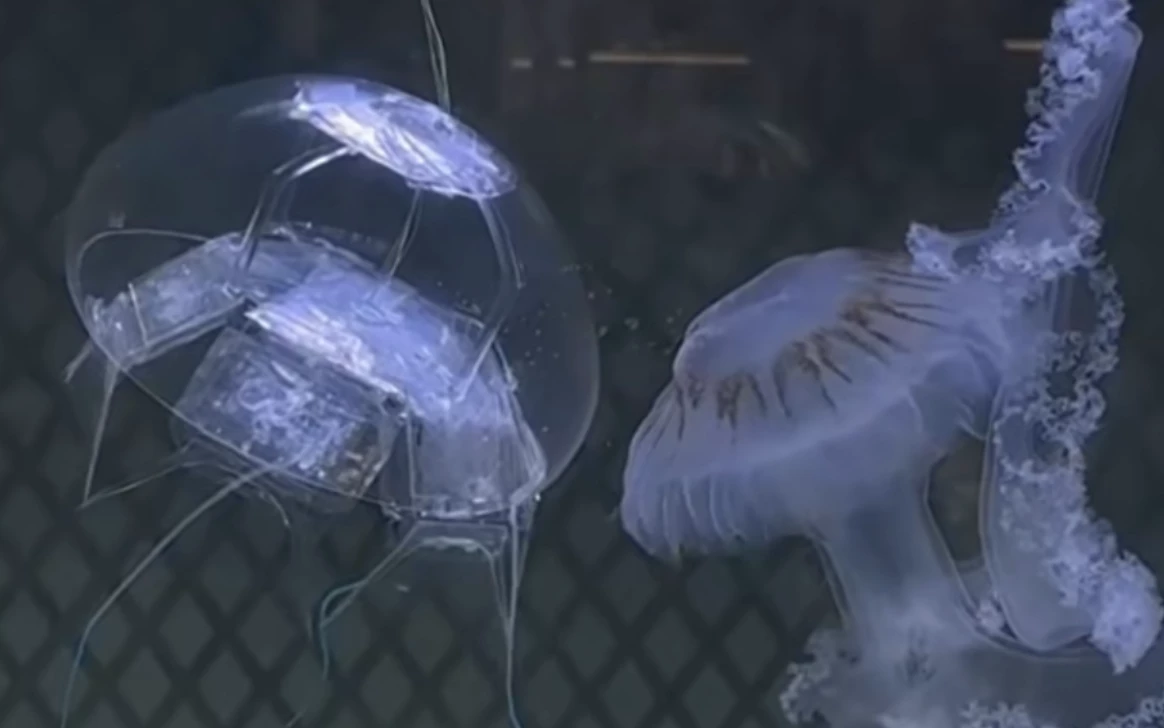Blurring the line between biology and robotics, Chinese scientists are taking biomimicry to new depths with a small, low-energy bionic jellyfish that’s so lifelike in form and movement it’s almost indistinguishable from the real thing.
Developed at Northwestern Polytechnical University Xi’an, Shaanxi, the jellyfish robot nicknamed the “underwater ghost” (水下幽灵) has been intricately designed to not just look like a translucent ocean floater, but to move like one too. Engineers have reported that it uses novel electro-hydraulic muscle actuators and hydrogel electrode materials to replicate jellyfish propulsion in water, consuming as little as ~28.5 milliwatts as it moves about.
Northwestern Polytechnical University
The robot, measuring just 12 cm (4.7 in) in diameter and weighing 56 grams (2 oz), also has a built-in camera and AI chip to lock onto and identify underwater objects, potentially marking a new frontier of deep-sea surveillance and exploration. Because of its low power consumption, this type of device is designed more for long-range monitoring rather than brief exploratory dive missions.
While the basic statistics have been widely reported, less known are further details such as depth capability, speed, communications capacity and what it will be used for. And while it’s designed to look uncannily like a medusa (adult) jellyfish, making it hard for marine life and humans to identify as synthetic, any biologist might quickly identify an issue with this: predation. Given that sea turtles will mistake plastic bags for jellyfish, it’s easy to imagine that these underwater ghosts could end up monitoring the digestive systems of foraging animals instead.
Nonetheless, jellyfish have been in the biomimicry spotlight for more than a decade, with engineers eager to harness nature for new technologies. Last year, the California Institute of Technology (Caltech) revealed its work on developing a jellyfish-inspired deep-sea surveyor, taking movement and propulsion cues from these ancient free-swimming cnidarians.
“Jellyfish are the original ocean explorers, reaching its deepest corners and thriving just as well in tropical or polar waters,” said engineer John Dabiri, Centennial Chair Professor at Caltech, at the time. “Since they don’t have a brain or the ability to sense pain, we’ve been able to collaborate with bioethicists to develop this biohybrid robotic application in a way that’s ethically principled.”
Robotic Jellyfish Explorers
In 2020, North Carolina State University also developed a soft robotics prototype inspired by jellyfish, aimed at both underwater use and as a potential aid in medical procedures.
This latest innovation, however, takes the biomimicry to a startling new level, with a transparent body and lifelike tentacles (fortunately without stinging nematocysts). It’s equipped with an electrostatic hydraulic actuator (EHA) that closely mimics the neural signals that give jellyfish their famous pulse-like locomotion.
The project was spearheaded by Professor Kai Tao, NPU’s school of mechanical and electrical engineering, which has so far produced some impressive biomimicry technologies – including a graceful 470-kg (1,036-lb) manta ray-like soft robot that glides underwater much like the real thing. In 2021, scientists demonstrated its data-gathering abilities – including being able to dive to depths of 1,025 m (3,363 ft) – around the Xisha (Paracel) Islands in the South China Sea. Researchers at the university have also been developing ways to optimize jumping locomotion in robotics, taking cues from insects, amphibians and vertebrates, and investigating the use of gecko-style bots.

China Daily/Northwestern Polytechnical University
According to Chinese reports, Tao demonstrated the jellyfish in action on state media CCTV, showing it moving around in different water conditions and accurately recognizing objects including the NPU emblem and a clownfish.
On October 21, Tao Kai told China’s official newspaper of the Ministry of Science and Technology, Science and Technology Daily, that the “low power consumption, low noise and highly biomimetic characteristics of this biomimetic jellyfish robot give it unique advantages in scenarios such as covert monitoring in the deep sea, observation of ecologically sensitive areas, and fine inspection of underwater facilities, providing an innovative solution to the key technical bottlenecks faced in deep-sea extreme environment exploration.”


